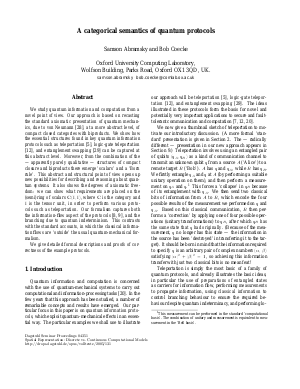Discrete classical vs. continuous quantum data in abstract quantum mechanics
Authors Samson Abramsky, Bob Coecke
-
Part of:
Volume:
Dagstuhl Seminar Proceedings, Volume 4351
Part of: Series: Dagstuhl Seminar Proceedings (DagSemProc) - License:
 Creative Commons Attribution 4.0 International license
Creative Commons Attribution 4.0 International license
- Publication Date: 2005-04-22
Files

PDF
DagSemProc.04351.14.pdf
- Filesize: 258 kB
- 21 pages
PDF
DagSemProc.04351.14-add.pdf
- Filesize: 31 kB
Document Identifiers
Subject Classification
Keywords
- Category theory
- strong compact closure
- quantum information-flow
Metrics
- Access Statistics
-
Total Accesses (updated on a weekly basis)
0Document
0Metadata
Abstract
``Quantum'' stands for for the concepts (both operational and formal) which had to be added to classical physics in order to understand otherwise unexplainable observed phenomena such as the structure of the spectral lines in atomic spectra. While the basic part of classical mechanics deals with the (essentially) reversible dynamics, quantum required adding the notions of ``measurement'' and (possibly non-local) ``correlations'' to the discussion. Crucially, all this comes with a ``probabilistic calculus''. The corresponding mathematical formalism was considered to have reached maturity in [von Neumann 1932], but there are some manifest problems with that formalism: (i) While measurements are applied to physical systems, application of their formal counterpart (i.e. a self-adjoint linear operator) to the vector representing that state of the system in no way reflects how the state changes during the act of measurement. Analogously, the composite of two self-adjoint operators has no physical significance while in practice measurements can be effectuated sequentially. More generally, the formal types in von Neumann's formalism do not reflect the nature of the corresponding underlying concept at all! (ii) Part of the problem regarding the measurements discussed above is that in the von Neumann formalism there is no place for storage, manipulation and exchange of the classical data obtained from measurements. Protocols such as quantum teleportation involving these cannot be given a full formal description. (iii) The behavioral properties of quantum entanglement which for example enable continuous data exchange using only finitary communication are hidden in the formalism. In [Abramsky and Coecke 2004] we addressed all these problems, and in addition provided a purely categorical axiomatization of quantum mechanics. The concepts of the abstract quantum mechanics are formulated relative to a strongly compact closed category with biproducts (of which the category FdHilb of finite dimensional Hilbert spaces and linear maps is an example). Preparations, measurements, either destructive or not, classical data exchange are all morphisms in that category, and their types fully reflect their kinds. Correctness properties of standard quantum protocols can be abstractly proven. Surprisingly, in this seemingly purely qualitative setting even the quantitative Born rule arises, that is the rule which tells you how to calculate the probabilities. Indeed, each such category has as endomorphism Hom of the tensor unit an abelian semiring of `scalars', and a special subset of these scalars will play the role of weights: each scalar induces a natural transformation which propagates through physical processes, and when a `state' undergoes a `measurement', the composition of the corresponding morphisms gives rise to the weight. Hence the probabilistic weights live within the category of processes. J. von Neumann. Mathematische Grundlagen der Quantenmechanik. Springer-Verlag (1932). English translation in Mathematical Foundations of Quantum Mechanics. Princeton University Press (1955). S. Abramsky and B. Coecke. A categorical semantics of quantum protocols. In the proceedings of LiCS'04 (2004). An extended version is available at arXiv:quant-ph/0402130 A more reader friendly version entitled `Quantum information flow, concretely, abstractly' is at http://www.vub.ac.be/CLEA/Bob/Papers/QPL.pdf
Cite As Get BibTex
Samson Abramsky and Bob Coecke. Discrete classical vs. continuous quantum data in abstract quantum mechanics. In Spatial Representation: Discrete vs. Continuous Computational Models. Dagstuhl Seminar Proceedings, Volume 4351, pp. 1-21, Schloss Dagstuhl – Leibniz-Zentrum für Informatik (2005)
https://doi.org/10.4230/DagSemProc.04351.14
BibTex
@InProceedings{abramsky_et_al:DagSemProc.04351.14,
author = {Abramsky, Samson and Coecke, Bob},
title = {{Discrete classical vs. continuous quantum data in abstract quantum mechanics}},
booktitle = {Spatial Representation: Discrete vs. Continuous Computational Models},
pages = {1--21},
series = {Dagstuhl Seminar Proceedings (DagSemProc)},
ISSN = {1862-4405},
year = {2005},
volume = {4351},
editor = {Ralph Kopperman and Michael B. Smyth and Dieter Spreen and Julian Webster},
publisher = {Schloss Dagstuhl -- Leibniz-Zentrum f{\"u}r Informatik},
address = {Dagstuhl, Germany},
URL = {https://drops.dagstuhl.de/entities/document/10.4230/DagSemProc.04351.14},
URN = {urn:nbn:de:0030-drops-1316},
doi = {10.4230/DagSemProc.04351.14},
annote = {Keywords: Category theory , strong compact closure , quantum information-flow}
}
